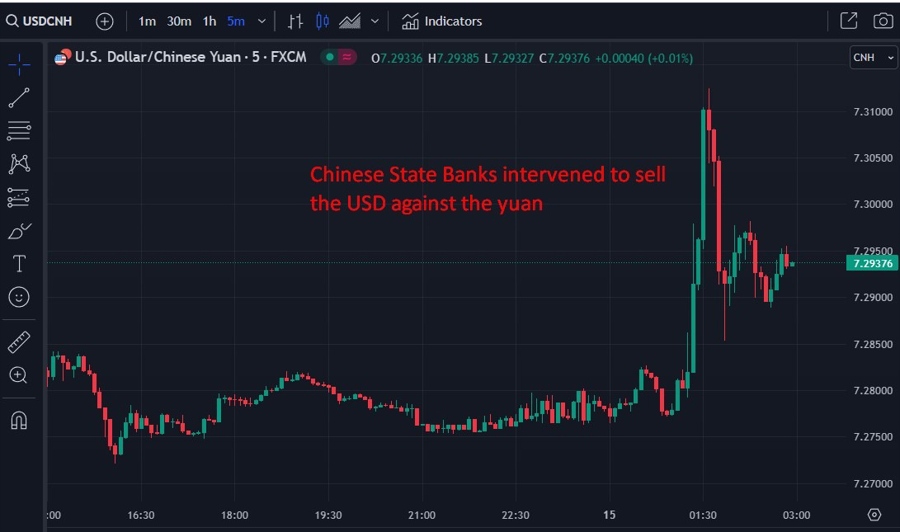- China state banks have been intervening to buy yuan
- The Grayscale Bitcoin ETF case decision could come as soon as Tuesday US time
- China July Industrial production +3.7% y/y (expected 4.5%) & Retail sales +2.5% (4.8%)
- RBA minutes: credible path back to CPI target with cash rate staying at its present level
- Australian wages data for Q2 +0.8% q/q (expected +1.0%)
- Offshore yuan getting slammed lower after surprise PBOC rate cuts
- People's Bank of China set MLF rate at 2.5%, big cut from prior 2.65%
- PBOC sets USD/ CNY reference rate for today at 7.1768 (vs. estimate at 7.2648)
- Add this to the data agenda today - PBOC MLF announcement due 15 August 2023
- JP Morgan warning on China property sector developments: "may set off a vicious cycle"
- Reserve Bank of Australia August meeting minutes today preview - hawkish skew likely
- Japan preliminary Q2 GDP +1.5% q/q (vs. expected +0.8%)
- Australia data - ANZ Roy Morgan weekly consumer confidence 81.4 (prior 78.2)
- Reserve Bank of New Zealand meet Wednesday - on hold expected - preview
- Goldman Sachs expects support for risk assets in the months ahead from rates, oil prices
- Nasdaq, S&P500: JP Morgan see a greater chance of a pullback - last week not enough
- Former Dallas Federal Reserve President Kaplan expects FOMC interest rate cuts in 2024
- US Treas Sec Yellen says US inflation is falling, wary of slowing China growth spillover
- Goldman Sachs on the best opportunity to buy bonds in a decade
- HSBC see AUD as oversold but China worries argue against too much of a bounce
- Signs of euphoria in Brent, WTI oil forecasts - but challenges ahead to cap the price
- Major indices are close higher to start the new trading week
- Forexlive Americas FX news wrap: China fears fizzle
- Trade ideas thread - Tuesday, 15 August 2023
The first event of note for the session was the very strong Japanese economic growth data for Q2. Q2 preliminary GDP came in much better than expected at 6% annualized, surging past the 3% forecast on strong net exports, led by auto shipments and inbound travellers. On the disappointing side though, domestic consumption and business spending missed estimates. The 6% growth on a y/y basis was the fastest pace since Q4 2020.
Also in the figures were inflation indications. The Deflator is a measure of inflation and it jumped to +3.4%, its highest since Q1 of way back in 1981. As we’ve heard time and again from the Bank of Japan, they expect inflation to be transitory. How much longer can they go on saying this though?
USD/JPY has not done a real lot on the session, tracking a narrow range, for it, around 145.50.
While the Japanese data was a surprise, there were more to come.
The People’s Bank of China cut rates for the second time in three months, lopping the Medium-term Lending Facility (MLF) rate to 2.5% from its prior 2.65% and the reverse repo rate from 1.9% to 1.8%. These cuts were soon followed by Chinese ‘economic activity’ data for July, which came in at big misses for industrial output and retail sales. The youth unemployment rate … well, no one knows, Chinese authorities say they are no longer publishing this particular data. This will not be because its improving.
USD/CNY and USD/CNH both rocketed higher after the PBOC rate cuts. Chinese State Banks were seen in the market selling USD/yuan in an intervention to prop up the local currency.
In amongst all this were the minutes of the Reserve Bank of Australia August meeting, when the Bank left the cash rate on hold. The RBA struck a less hawkish tone than was expected. Also in the mix were wages data for Q2 from Australia, which came in lower than expected. The RBA will read this as taking some heat out of inflation pressure.
AUD/USD was marked lower on this combination of Chinese rate cuts, a gentler RBA, and the miss on wages. As I post, though, it has recovered all lost ground and is just a touch higher on the session.
Elsewhere FX ranges have also been subdued. Chinese mainland and Hong Kong stocks are a little weaker.
Asian equity markets:
Japan’s Nikkei 225 +0.8%
China’s Shanghai Composite -0.03%
Hong Kong’s Hang Seng -0.6%
South Korea’s KOSPI -0.8%
Australia’s S&P/ASX 200 +0.7%




